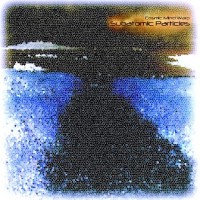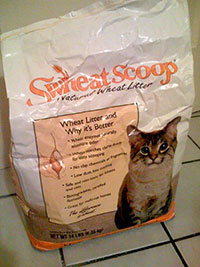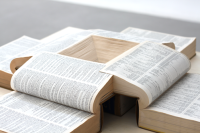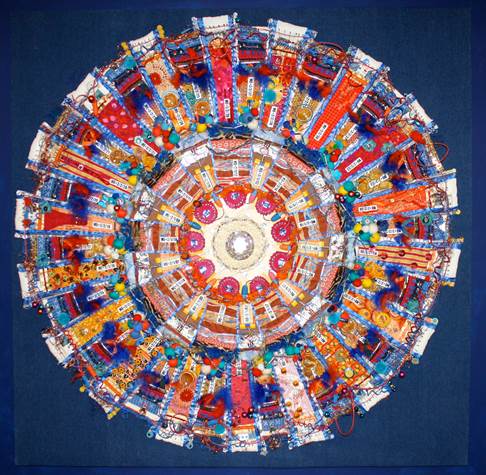By Michael Banks
From a physicist creating an award-winning beer to a font based on Albert Einstein’s handwriting, physics has offered up its fair share of interesting stories this year. Here is our pick of the 10 best, in chronological order.
UK to open its first “pub observatory”
Fancy having a few pints while gazing at the stars? Well soon you could do just that, thanks to a new initiative at the Barge Inn in Honeystreet on the banks of the Kennet and Avon Canal in Wiltshire, UK.

The Barge Inn. (Courtesy: The Barge Inn)
The boozer is already a favourite among UFO aficionados and crop-circle hunters, but now the free house, which has its own brewery making beers such as Alien Abduction and Roswell, is creating the UK’s first pub observatory. The 205-year-old, rural inn received planning permission earlier this year from Wiltshire County Council to construct a 6 m-tall domed observatory in its neighbouring campsite.
Dubbed the Honeystreet Observatory, it will be able to accommodate groups of about 20 people and will feature a Celestron 14″ 1400 Pro telescope. Images from the instrument will also be relayed onto screens in the pub.
But will it be a good idea to mix alcohol with astronomy, particularly with the tricky ascent to the telescope? “Gazing at the stars and falling down the stairs is a regular activity, so we think it will be business as usual,” says pub landlord Ian McIvor. The observatory is set to open in spring 2016 and Physics World editorial staff are looking forward to checking out this important new scientific venue.
Read all about it
Desperate for a last-minute Christmas gift? Well look no further than a 45-page e-book for only £3.83. The 71-year-old theoretical physicist Paul Frampton, who was arrested in Argentina in 2012 with 2 kg of cocaine in his luggage, released his own version of events earlier this year in the e-book Tricked!: the Story of an Internet Scam.
The British-born physicist travelled to Argentina after believing that he had struck up a correspondence online with Czech-born lingerie model Denise Milani. However, when he arrived, Milani was nowhere to be seen but Frampton was apparently asked by someone else to carry a suitcase for her, which turned out to contain the drugs. Despite protesting his innocence, Frampton was sentenced in November 2012 to 56 months in jail in Buenos Aires, some of which he spent under house arrest.
In the e-book Frampton outlines “the true story of an adventure that I would rather not have had”. According to the book’s blurb, it provides an “important lesson” that is “essential reading for everybody who uses the Internet”.
The LEGO Large Hadron Collider

LEGO Large Hadron Collider.
This year saw Nathan Readioff of the University of Liverpool in the UK create a 371-piece, officially endorsed LEGO Large Hadron Collider (LHC) model.
The kit contains small replicas of each of the four main detectors at CERN – ALICE, ATLAS, CMS and LHCb – as well as magnets that are placed between them. Each detector took Readioff around 40 hours to design, but you’ll be glad to know that it only takes about 10 minutes to build each of them.
“All the [detector] groups have been most enthusiastic about my miniatures, and they were a great help in gaining approval from CERN,” says Readioff, who works on ATLAS and has loved playing with LEGO “since childhood”.
Readioff shared his design on the LEGO Ideas site and is now looking for the 10,000 supporters required for LEGO to conduct a formal review of it. If the model receives the green light, it would then go into a “development phase”, where LEGO designers refine the product for commercial release.
Readioff has gained about 6400 supporters so far, still some way from the target. “If we could get something like this on sale in stores, it could serve as a fabulous introduction to the amazing work that is done here at CERN,” adds Readioff.
Particle-physics electronica

Subatomic Particles by duo Cosmic Mind Warp.
If you fancy a bit of particle-physics electronica, then make sure you download the latest album from Isle of Wight electronic duo Cosmic Mind Warp that was released this year. In a “unique crossover” between the worlds of cosmology, quantum physics and electronic music, Alister Staniland and David Holmberg have released a concept album dubbed Subatomic Particles.
The 15-track album, which features songs such as “Large Hadron Collider”, “Quantum tunnelling” and “Down quark”, is described by the duo as a “hallucinogenic head-trip through the microscopic world of subatomic particles and the strangeness of quantum physics”.
Staniland says he has always been “naturally” interested in physics, having watched documentaries on TV as well as on YouTube. “Our music is quite spacey and we’ve often made tracks that have some reference to space,” says Staniland. So does the band have plans for another physics-inspired album? “We’re not going to rule it out,” he says. “If anyone can suggest an area of physics that might be particularly suitable, maybe we’ll look at creating a companion EP.”
Littered with errors
Cat litter and radioactive waste – two phrases you wouldn’t normally expect in the same sentence. But a 277-page report by the US Department of Energy has squarely blamed kitty litter for the explosion of a single drum of nuclear waste – dubbed “68660” – at the Waste Isolation Pilot Plant (WIPP) in New Mexico.

Explosive stuff.
A year-long investigation by a nine-member panel – led by David Wilson of the Savannah River National Laboratory – concluded that the incident in February 2014 was caused by the use of the wrong brand of feline litter. As cat litter is highly absorbent, it is used to help keep nuclear waste contained, with around 26 kg of the stuff in each barrel of waste at the WIPP.
However, workers at the Los Alamos National Laboratory – where the barrel originated – switched from using inorganic cat litter to the Swheat Scoop brand, which is made from natural products and contains wheat. As the cereal grain is composed of carbohydrates, it provided fuel for a chemical reaction with the disposed metal nitrite salts. This exothermic reaction warmed the drum, eventually producing enough heat to make it explode. Swheat Scoop is described by the firm as “earth friendly, 100 per cent biodegradable and safe for everyone in the house”. Unless, of course, you mix it with nuclear material.
Font of all knowledge
If you find that your colleagues are not taking you seriously, why not start sending them e-mails in a new font that mimics the handwriting of Albert Einstein? The font has been developed by the German typographer Harald Geisler together with US-born dancer Elizabeth Waterhouse, who has a degree in physics from Harvard University.
Geisler combed through samples of Einstein’s writings to gain an understanding of both how the physicist formed his letters and the pen strokes he used to write them. The idea for the font was accepted by the Einstein estate last year and Geisler swiftly got to work.
Geisler, who has already created a font based on the writings of Sigmund Freud, told physicsworld.com that he is now planning his next project, which will be “based on a woman’s handwriting”. Apparently, the duo has a historical figure in mind and is planning to launch the project next year.
Shoestring physics
When Evan Eames – a Canadian astrophysics student at the University of Manchester in the UK – could not afford living costs on top of his international tuition fees of almost £20,000, he came up with a novel solution. Posting an advert on Gumtree – a classified-ad site – the Master’s student asked if he could pitch his tent in someone’s backyard during the 10-month course to save on rent.
When Stockport resident Charley Mantack agreed, the 24-year-old postgrad went on to camp in her back garden in all weathers that the English climate could throw at him. In exchange, the self-professed “camping enthusiast” tutored Mantack in maths and physics as she was studying for GCSEs at Stockport College.
Apart from spending the odd night on Mantack’s sofa, Eames says it was easier than expected and even fun at times. “The rain and dampness of Manchester was a tricky issue,” says Eames. “But I did get better at dealing with it.” Eames has now moved to Paris to do a PhD in physics. We hope he found more suitable accommodation there.
Friction between the sheets
Ever tried – and duly failed – to pull apart two interleaved phone books? Well, a team of researchers from France and Canada, led by Héctor Alarcón of the University Paris-Sud, has now studied why this is such an impossible task.

Physics explains why it is so hard to pull apart two interleaved phone directories. (CC BY SA Mark Longair)
The difficulty in separating them is caused by the friction between the sheets, which is amplified by the huge number of pages in a directory. However, friction only occurs when two surfaces rub against each other and researchers were not sure how exactly this happens.
Gravity was one explanation, but this can be refuted by holding the directories vertically. By performing experiments and carrying out computer modelling, Alarcón and colleagues conclude that the pulling itself generates a force that brings the sheets together – so the harder you pull, the more tightly the pages bind (arXiv:1508.03290).
They researchers also found that a relatively small increase in the number of pages has a dramatic effect on the pulling force necessary to separate them, so that a 10-fold increase in pages creates a four orders of magnitude increase in the force.
Surely a contender for next year’s IgNobel prize?
Homebrew physics

Cambridge University astrophysicist Will Alston with his winning tipple. (Courtesy: Will Alston/Thornbridge Brewery)
An astrophysicist from the University of Cambridge in the UK was the surprise winner of an award at this year’s Great British Homebrew Challenge for the quality of his beer. Seeing off some 200 rival entries, the tipple was created by postdoc Will Alston using rhubarb from his allotment to provide an extra twist.
The judges for the national competition noted that the beverage, dubbed Rhubarbe de Saison, was “a refreshingly easy-drinking beer with complex flavours that came together well”. Alston, who studies black holes when he’s not brewing beer, told physicsworld.com that he was “really pleased” with the beer and that it had gone down well with his friends. “I was very surprised [to win] as this was the first competition I’ve entered,” he adds.
As well as winning the £250 top prize, the brew has also been made by Thornbridge Brewery, which sponsors the gong. So will Alston be giving up the day job? “I am not going to rush into anything just yet,” he says. “[But] I would love to set up my own microbrewery one day.”
CMS on canvas

Collage of the CMS detector at CERN created by Genevieve Lovegrove.
And finally, using items as diverse as a bra strap, batteries, pompoms, feathers, marbles and even painkillers and Christmas baubles, University of Leicester modern-literature student Genevieve Lovegrove has created a collage of the LHC detector made from everyday objects. She says she was inspired to create the work after seeing a photograph of the famous detector in a newspaper and was struck by its “beauty and impact”, as well as the “groundbreaking” science done at the LHC.
Lovegrove says that the project took three months to create at a cost of about £1000, yet the biggest strain was apparently on her daughter, who “was somewhat fed up with having a two-metre CMS in the lounge”. Anyone keen to see Lovegrove’s collage up close can head to the UK university’s physics department, where it will now be put on permanent display in the foyer.
That’s it for this year, but you can be sure that the next 12 months will throw up their fair share of quirky stories from the world of physics. See you in 2016!
I like the “Friction between the sheets” one actually, and I’m waiting for more updates about this news.